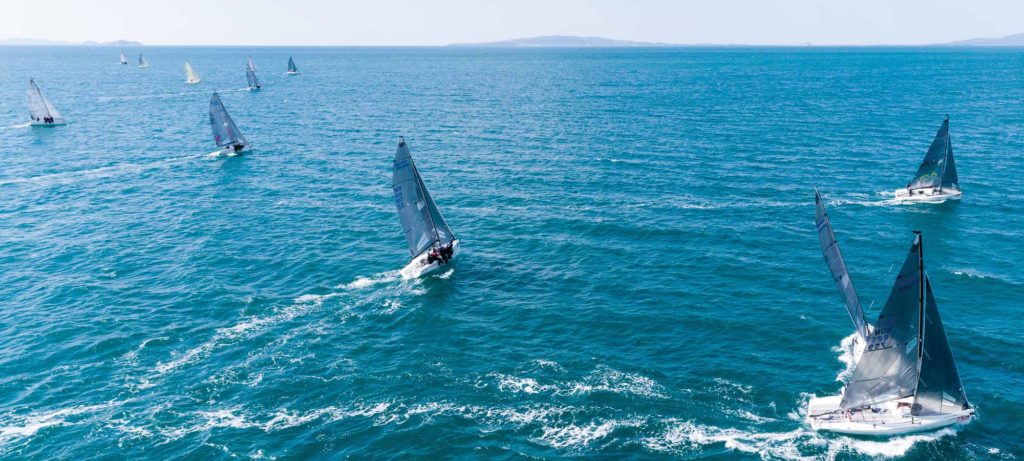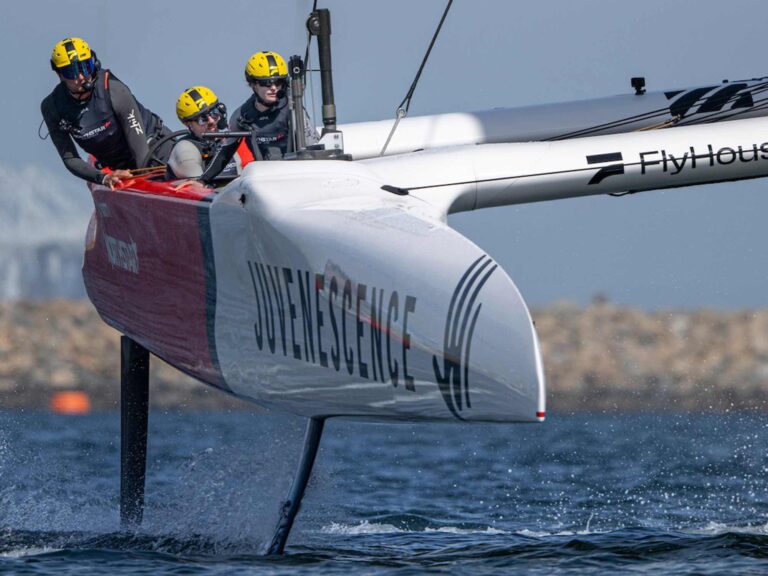
“Are we on the long tack?”
I ask because our tactician is having a noticeably hard time figuring out what to do. “Uh … no,” our tactician responds. “OK,” I say. “Let’s tack, then we can sort it out.”
It’s not that he is doing anything wrong, but the tactician’s job is tough, and it’s a tricky day. “Agreed. Tack when you’re ready,” he says, sounding relieved.
The long tack is a way to ensure we are sailing the shortest distance to the mark. It’s also a conservative move, a way to bring us back toward the center of the racecourse when unsure of the best move, which is surprisingly often. But while we assess what to do, at least we are not hurling ourselves toward the corner for no clear reason.
I define the long tack or long jibe as “the tack that points your boat closest to the next mark from your current location.” It’s the tack or jibe that takes you back toward course center. The center of the course is the wind center. It is directly downwind of the weather mark on a beat and directly upwind of the leeward mark on a run. It ignores the previous mark and instead only relates to where you are relative to the next mark and the wind direction. If you are going upwind and left of the wind center, then you are on the left side and port is the long tack. If you are right of wind center, you are on the right side and starboard is the long tack.
The long tack can change two ways: either by your boat crossing the center of the course, or the wind shifting from one side of the mark to the other. Suppose, for example, you are going upwind on the right side of the course on starboard, which is the long tack. Eventually, that will take you to the center, and as you cross downwind of the mark, it will change from the long to short tack, even though you have not tacked. Suppose, in that same scenario of being on starboard on the long tack, this time you get a header. If the header is enough so that the wind shifts from right of the mark to left of the mark, then suddenly you are on the short tack even though you have neither tacked nor gone very far.
The best way to tell if you are on the long tack is simply to look at the next mark and gauge how far off the bow it is. If it is more or less in your forward line of sight, you are on the long tack. If you have to look way over your shoulder to find it, you are on the short tack. To train your sight, make your best guess at finding the center of the course and then look over your shoulder to see how far you have to look to see the mark. Tack and see if you are looking at the mark with the same head and body twist as on the other tack.
The goal is to learn the scale of the short tack to long tack. I like to put it in a ratio:
At 1-to-2, the mark is easily in your field of vision. If it’s more like 1-to-3 or 1-to-4, you barely need to look from your jib telltales to see it. Either way, you are solidly on the long tack heading toward the center — it feels right.
At 1-to-1, both tacks are equal. You are directly to leeward of the mark. You can see it by turning you head, but it’s not a stretch. You are comfortably in the middle of the course, with all options open.
At 2-to-1, you will have to look well over your shoulder to see the mark. You are solidly on the short tack. It should be a significant factor in your tactical conversation — you should start to feel uneasy.
At 3-to-1 or more, you have to all but turn around to see the mark. You are way off the center of the course. You had better have a really good reason to keep going into the corner — you should be getting really nervous.
The long tack is so powerful because you are traveling the shortest distance to the mark while avoiding big risk. More often than not, it’s the winning move. Here are some examples.
Randomly shifty day: When it’s shifty and we have not nailed down a pattern, staying on the long tack may be our primary strategy. We might say, “If we are not pointed near the mark, we are probably on the wrong tack.”
Tacking in the big shifts to stay on the long tack centers us up to take advantage of the next shift, all while heading more or less toward the mark and making velocity-made-good gains up the course. If we find ourselves getting toward an edge, using the long tack compels us to take a smaller shift toward the center of the course, even if we take what we would have considered a header if we were watching the compass. By using the long tack to define a lift instead of a compass heading, we are always sailing the shortest distance and avoid getting stuck on an edge where we can no longer take advantage of those big shifts.
Oscillating-breeze day: Even if the wind is oscillating and we think we have a handle on the shifts, the long tack serves as a sanity check. In these conditions, playing the shifts by watching the compass ought to more or less keep us on the long tack. “Up 10, on the long tack” is what I like to hear. “Up 10, but we are on the short tack” sounds an alarm. We might have decided on the wrong mean compass heading, or maybe the wind has changed and there is a new mean. Either way, once we get on the short tack by 2-to-1 while still on a lifted heading, we start looking for any excuse to tack. Our tactician might say, “We are no longer up 10, but we are up 5 and significantly on the short tack. Let’s tack and hedge our way back toward center.” This is a tricky move since we have to eat what we think is a header. But it is a conservative move that can be a regatta saver. Once back on the long tack, heading toward the center, it’s a good time to re-establish the mean.
Layline avoidance: Nothing good happens on a long layline. If headed, we can’t tack to take advantage of a lift. Get lifted, and we overstand and sail extra distance. Even if there is no shift, there is a high probability we will get tacked on and have to sail in dirty air with no good option to escape. All three scenarios we lose.
Spiraling in: Another layline issue is “spiraling in” on the mark. It is a frustrating situation that happens when we are significantly on the short tack and get lifted just when we were counting on a header. We desperately want to tack because we are approaching the layline, but hesitate because of the lift. Before we know it, we are well on the short tack and running out of options. Instead, if we had the discussion when it was 2-to-1 and hedged our way back even part way, we would have avoided the problem — another regatta-saving move.
Indecision: When we are unsure what to do, the long tack gives us time to regroup and figure things out. If we are confused and instead sail the short tack, we are committing to a side. We had better be right. The weather is going to do what it is going to do. Sometimes we can figure it out, but many times we cannot. The long tack keeps our options open while giving us time to think — it’s all good.
Great way to start each leg: The long tack is a solid conservative first move off the start or at the beginning of any leg. Taking the short tack early in a leg quickly and unnecessarily commits us to a side, and that is risky. The long tack early leaves all options open because we can still decide to get on the short tack in time to take advantage of that side, or we can continue on the long tack and center up. The long tack for the first leg is easy to tell with a wind shot before the start. Before rounding the mark onto subsequent legs, you should discuss which tack will be longer. You often will be able to tell based on what shift you are on, and which tack you just spent the most time on.
Tacking in the big shifts to stay on the long tack centers us up to take advantage of the next shift, all while heading more or less toward the mark and making velocity-made-good gains up the course.
Current: Race committees don’t always square up the racecourse to the current because they set it to the true wind, as seen on their anchored committee boat. If there is a side current, it will significantly skew one tack to be the long tack. The safe move is to take that long tack first. In current, we can tell which is the long tack for the leg by doing a head to wind before the start. Our apparent wind is what we sail in, not what the race committee is reading. If in doubt, sailing the tack that takes us more up-current than the other tack is typically the long tack.
Downwind: Sailing the long tack is arguably even more powerful downwind. As when sailing upwind, it helps when it’s super shifty, is a sanity check for playing oscillations and helps avoid layline issues. When unsure what to do, it brings us back to the center, where we have options. It can be even more significant downwind because jibing angles are typically so much tighter than tacking angles.
In strong winds, if port is the long tack for the leg, we have to jibe right away to port because we will already be overstood. Any time sailed on starboard is just overstanding more. And it gets worse. Once we jibe to port, the fleet will inevitably jibe on us — all bad.
Does the long tack always work? Nope. There are plenty of good reasons to sail the short tack, but keep in the forefront of your mind that anytime you choose to sail the tack taking you on a longer distance (the short tack), there better be a bigger gain to be had than the distance you are sacrificing. Below are some situations in which sailing the short tack is the right thing to do.
Racing to a side: Some days dictate going to a side. This could be a persistent shift, a geographic effect (shift, waves state, and more wind) or current (relief or help). In each case, heading to a side means we will likely be sailing on the short tack to get to the side we want. There is nothing wrong with this strategy if we are pretty confident it will pay off.
Sailing to pressure: We all but ignore the long-tack concept in light wind because sailing to pressure dominates our strategy. Sometimes the winning play will be connecting puffs, other times we will race all the way to a side where we see more wind. Either way, we do not hesitate to take the short tack if it means getting to greater wind velocity.
Nearing a mark: As we approach the next mark, the long tack becomes less useful because the leverage from one side to the other is so much less. The closer we get, the more we prioritize planning our final approach based on traffic management. Sure, the long tack is related to the layline. But as we approach the mark, we change our focus to the winning move to the mark instead of using the long tack to center us.
Our original conversation at the beginning of this story could have been quite different: “Are we on the long tack?” I would ask. “No, but there is a line of pressure ahead I want to get into before we tack,” our tactician might respond with confidence. That is a great reason to sail the short tack. But more often than not, sailing the long tack works. First and foremost, by sailing the long tack, you are sailing a short race. As a bonus, it keeps you heading to the center, where you still have choices, and avoids the trouble of the corners. Sure, by sailing the long tack you can miss out on being a hero with a big gain in the corner. But on the whole, the long tack helps you sail a series of solid races rather than dominating one race and bombing the rest.









